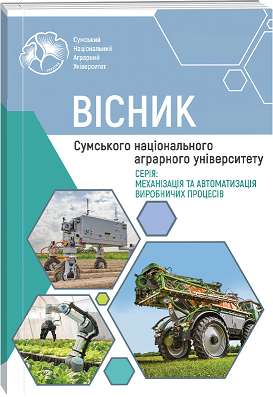IMPROVING THE EFFICIENCY OF NITROCEMENTATION TECHNOLOGY WITH ELECTROSPARK ALLOYING
Abstract
A new process for the nitro cementation of steel surfaces based on electrospark alloying (ESA) is proposed, which consists in the pretreatment of the surface with an aluminium electrode, followed by the application of a nitrogen-containing paste and subsequent alloying with a graphite electrode. This process is an innovative approach to increasing the wear resistance and strength of metallic materials of the coating-substrate type. The main goal of the investigation was to determine the effect of the energy parameters of the alloying process on the key quality indicators of the obtained coatings. The effect of discharge energy on layer thickness, microhardness, continuity and surface roughness was investigated. The results of metallographic and durometric tests indicate that nitrogen-containing coatings consist of a hardened «white» layer that gradually transitions to the diffusion zone and the substrate metal. The coatings obtained have a «white layer» thickness of 100-110 μm. The durometric tests show an increase in microhardness to 6800-10380 MPa. The phase composition of the coatings is represented by cubic iron nitride and iron carbide alloyed with ferrite. The use of ESA allows a reduction in energy consumption and processing time compared to traditional chemical heat treatment methods. The absence of the need for full heating of the part reduces the risk of thermal deformation and preserves the original mechanical properties of the base metal. The proposed method of nitro-cementation based on electrospark alloying is a promising technology for strengthening the surfaces of steel parts. The use of a combined approach involving pre-treatment with an aluminium electrode, application of a nitrogen-containing paste and alloying with a graphite electrode allows high microhardness, thickness and continuity of the coatings to be achieved. This gives new possibilities for increasing the wear resistance and durability of important parts and components of pumping and compressor equipment, contributing to the development of modern technologies in the field of materials science and surface engineering. Further research in this area could be aimed at optimising the technological parameters of the electrospark alloying process to improve the efficiency and quality of the coatings obtained. This may include studying the effect of different types of electrodes, alloying modes and processing conditions on the structural and mechanical properties of coatings.
References
2. Baidych L.E., Rohozha Yu. A. (2009). Koroziina stiikist azotovanykh shariv na staliakh v shyrokomu diapazoni pH: stattia. [Corrosion resistance of nitroded layerson steel in a wide range of pH: article]. Khmelnytsk: Visnyk Khmelnytskoho natsionalnoho universytetu. №5. (in Ukrainian).
3. Gaponova O. P., Okhrimenko V. O. Myslyvchenko O. M. Tarelnyk N. V. (2023). Vdoskonalennia tekhnolohii azotuvannia metodom elektroiskrovoho lehuvannia: stattia. [Improvement of nitriding technology by electrosparktreatment: article]. Kyiv: Metaloznavstvo ta obrobka metaliv. №29 (105). (in Ukrainian). https://doi.org/10.15407/mom2023.01.058.
4. Ivashchenko Ye. V., Lobachova H. H., Mazanko V. F. (2010). Formuvannia poverkhnevoho zmitsnenoho sharu pry khimiko- termichnii obrobtsi zaliza, poiednanii z elektroiskrovym lehuvanniam: stattia. [The surface hardened layer formation the chemical-heat treatment of iron, combined with electric-spark alloying: article]. Kyiv: Metaloznavstvo ta obrobka metaliv. (in Ukrainian). http://dspace.nbuv.gov.ua/handle/123456789/63618
5. Khranovska K. M., Mazanko V. F., Ivashchenko Ye. V., Lobachova H. H. (2010). Vplyv seredovyshcha lehuvannia ta dodatkovoho azotuvannia na mikrotverdist, strukturu ta fazovyi sklad zaliznoi pidkladky: stattia. [nfluence of the alloying environment and additional nitriding on the microhardness, structure and phase composition of the iron substrate: article]. Fyzycheskaia ynzheneryia poverkhnosty. T.8. № 4. (in Ukrainian). http://dspace.nbuv.gov.ua/handle/123456789/98919
6. Lobachova H .H. (2012). Modelni uiavlennia pro strukturno-fazovi peretvorennia u poverkhnevykh sharakh splaviv zaliza v protsesi EIL karbido- ta nitrydo-utvoriuiuchymy elementamy u nasychuvalnomu mizhelektrodnomu seredovyshchi z elementamy vtilennia : avtoref. dys. [Model representations of structural and phase transformations in the upper layers of iron alloys in the EIL process by carbide- and nitride-forming elements in a saturating interelectrode medium with impact elements: autoref. thesis]. Kyiv: NTUU « KPI im. I. Sikorskoho». (in Ukrainian).
7. Maksymov V. H., Hryhorova T. M. (2007). Osnovy rozrakhunku, proektuvannia ta ekspluatatsii tekhnolohichnoho obladnannia: Konspekt lektsii. [Basics of calculation, design, and operation of technological equipment: Synopsis of lectures.]. Odesa: Nauka i tekhnika. (in Ukrainian).
8. Mosina T. V. (2014) Electric-Spark Alloying of Composite Material of the Systems TiN–AlN and TiN–AlN–(Ni–Cr) as a Method for Applying Wear-Resistant Coatings: article. Refractories and Industrial Ceramics. №5 (54). (in English). https://doi.org/10.1007/s11148-014-9616-0
9. Okhrimenko V. O. (2022). Doslidzhennia vlastyvostei alitovanykh shariv pislia elektroiskrovoho lehuvannia: tezy. [Investigation of the properties of alite layers after electrospark treatment: theses.]. Zaporizhzhia: Zaporizkyi natsionalnyi universytet. p.221-223. (in Ukrainian).
10. Radek N., Bartkowiak K. (2010) Performance properties of electro-spark deposited carbide-ceramic coatings modified by laser beam: article. Physics Procedia. Vol.5, Part A. (in English). https://doi.org/10.1016/j.phpro.2010.08.163
11. Ahjin Sim, Chankyoo Park, Namhyun Kang, Yangdo Kim, Eun-Joon Chun. (2019). Effect of laser-assisted nitriding with a high-power diode laser on surface hardening of aluminum-containing martensitic steel: article. Optics and Laser Technology. №116. (in English). https://doi.org/10.1016/j.optlastec.2019.03.040
12. Tarelnyk V. B., Martsynkovskyi V. S., Gaponova O. P., Sarzhanov O. A. Hapon O. O., Lazarenko A. D., Mikulina M. A. (2021). Sposib nitrotsementatsii poverkhon stalevykh detalei: pat. Ukrainy na korysnu model [The method of nitrocementation over steel parts: pat. Ukraine on a custom model]. № 146373, S23S. № 7. (in Ukrainian).
13. Tarel’nyk V. B., Gaponova O. P., Konoplyanchenko Ye. V., Dovzhyk M. Ya. (2016). Investigation of Regularities of the Processes of Formation of Surface Layers with Electroerosive Alloying. Part I. article. Metallophysics and advanced technologies. Vol.38(№12). (in English). https://doi.org/10.15407/mfint.38.12.1611
14. Zavoiko O. S., Novikov S. M. (2013) Mekhanizm protsesu elektroiskrovoho lehuvannia iz hazovym osadzhenniam: stattia. [The mechanism of the process of electrospark treatment with gas deposition: article]. Ivano-Frankivsk: Prospecting and Development of Oil and Gas Fields. №3. (in Ukrainian).

 ISSN
ISSN  ISSN
ISSN 



